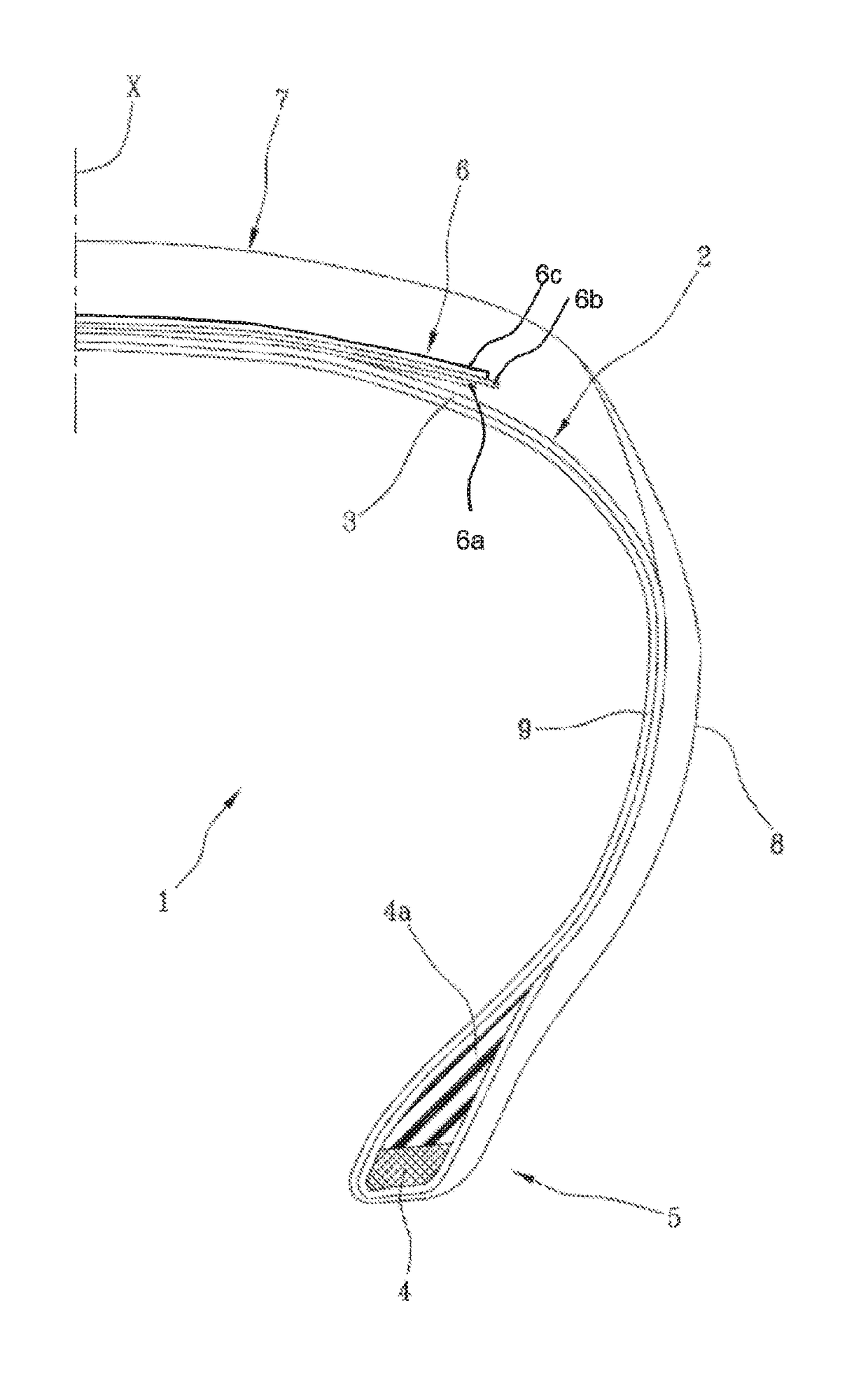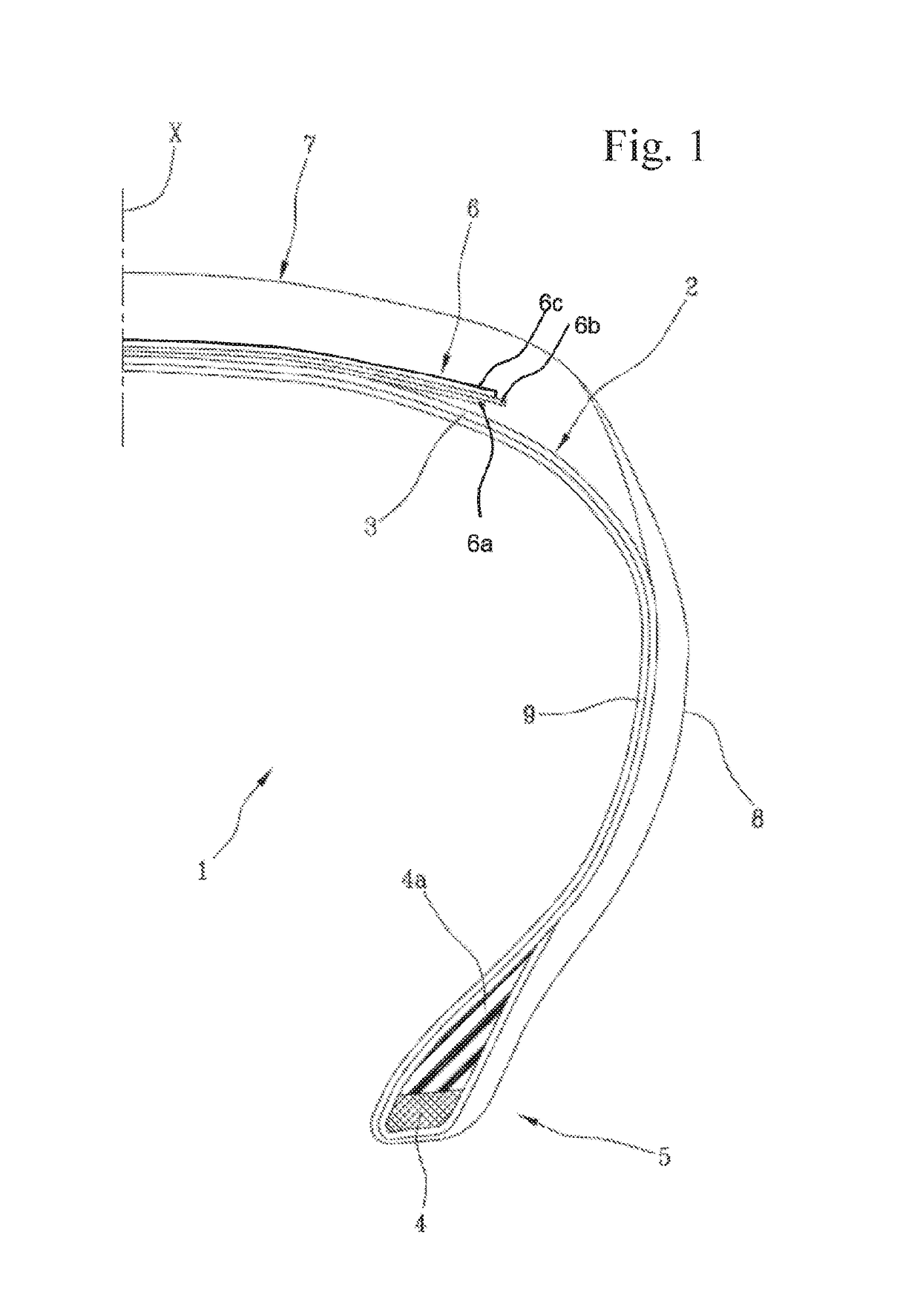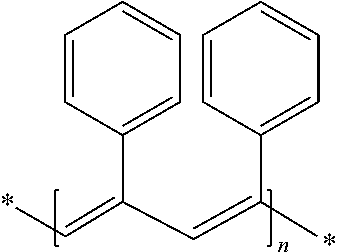High-performance tyre
- Summary
- Abstract
- Description
- Claims
- Application Information
AI Technical Summary
Benefits of technology
Problems solved by technology
Method used
Image
Examples
example 1
of (Isostyrene / Trans-Butadiene) with 72.8% by Weight of Styrene Free of Polyisoprene End Groups (Polymer S1)
[0117]50 ml of toluene, styrene (9.06 g; 0.087 mol), butadiene (3.1 g; 0.058 mol; 3 M solution in toluene) and MAO (0.0058 mol; 8 ml; 10 wt % solution in toluene) were placed in a 500 ml round-bottomed flask equipped with a magnetic stirrer, under an inert atmosphere. After bringing the solution to the reaction temperature (T=25° C.), the polymerization was initiated by adding the catalyst of formula 1 described previously (0.006 g; 58 μmol), dissolved in 1 ml of toluene. The reaction mixture was left stirring for 24 hours.
[0118]The polymerization was stopped by pouring the contents of the round-bottomed flask into ethanol acidified with HCl and 2,6-di-tert-butyl-4-methylphenol (BHT) as antioxidant.
[0119]The coagulated polymer was washed with ethanol, filtered and dried in a vacuum oven at 30-40° C. The yield was 90%. The resulting polymer had a molecular weight of about 329 0...
example 2
of Iso-Styrene:Isoprene-Terminated with 99.8% by Weight of Styrene and 0.2% by Weight of Terminal Isoprene (Polymer S2)
[0120]50 ml of toluene, isoprene (0.59 g; 0.0087 mol) and MAO (0.0058 mol; 8 ml; solution at 10 wt % in toluene) were placed in a 500 ml round-bottomed flask equipped with a magnetic stirrer, under an inert atmosphere. After bringing the solution to the reaction temperature (T=25° C.), the polymerization was initiated by adding the catalyst of formula 1 (0.006 g; 58 μmol), dissolved in 2 ml of toluene. The reaction mixture was left stirring for 2 hours. Next, styrene (7.7 g; 0.074 mol) was added to the reaction mixture, which was left stirring for a further 24 hours.
[0121]The polymerization is stopped by pouring the contents of the round-bottomed flask into ethanol acidified with HCl and 2,6-di-tert-butyl-4-methylphenol (BHT) as antioxidant.
[0122]The coagulated polymer was washed with ethanol, filtered and dried in a vacuum oven at 30-40° C. The yield was 80%. The r...
example 3
of Isoprene-Terminated Iso-Styrene-Co-Para-Methylstyrene Polymer with 99.8% by Weight of Styrene Including 5% of Para-Methylstyrene and 0.2% by Weight of Terminal Isoprene (Polymer S3)
[0123]70 ml of toluene, 1.66 g (24 mmol) of isoprene, 0.7 g of MAO (toluene solution at 10% by weight, equal to 12 mmol) and finally 6 mg of catalyst of formula 1 (0.01 mmol) dissolved in 2 ml of toluene were placed in a 100 ml round-bottomed flask equipped with a magnetic stirrer, under an inert atmosphere. The reaction was left stirring at room temperature for 2.5 hours. A mixture of 25.4 g of styrene and 2.51 g of p-methylstyrene was then added. The reaction mixture was left stirring at room temperature for 24 hours. The reaction was stopped with ethanol and the polymer was coagulated in ethanol acidified with HCl also containing hydroquinone as antioxidant. After washing with fresh ethanol, the polymer was recovered and dried under vacuum at 40° C.
[0124]The resulting polymer had a molecular weight ...
PUM
| Property | Measurement | Unit |
|---|---|---|
| Temperature | aaaaa | aaaaa |
| Temperature | aaaaa | aaaaa |
| Temperature | aaaaa | aaaaa |
Abstract
Description
Claims
Application Information
 Login to View More
Login to View More - R&D
- Intellectual Property
- Life Sciences
- Materials
- Tech Scout
- Unparalleled Data Quality
- Higher Quality Content
- 60% Fewer Hallucinations
Browse by: Latest US Patents, China's latest patents, Technical Efficacy Thesaurus, Application Domain, Technology Topic, Popular Technical Reports.
© 2025 PatSnap. All rights reserved.Legal|Privacy policy|Modern Slavery Act Transparency Statement|Sitemap|About US| Contact US: help@patsnap.com



